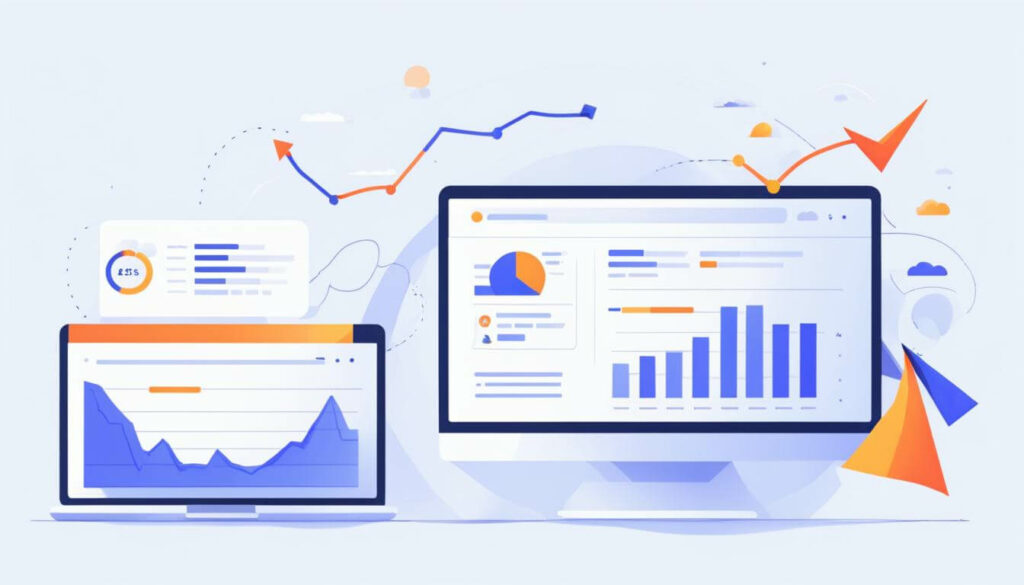When it comes to running a successful ecommerce business, understanding customer behavior on your website is key. One important metric that can provide valuable insights into user engagement and website performance is the bounce rate.
Bounce rate in ecommerce terminology refers to the percentage of visitors who leave your website without taking any action or exploring further. It indicates how well your website is engaging visitors and can help you identify areas for improvement to reduce customer drop-offs.
By analyzing bounce rate along with other website analytics, such as average time on site and conversion rates, you can gain a deeper understanding of how users interact with your site and uncover potential issues that may be hindering conversions or sales.
Bounce Rate
In ecommerce, bounce rate refers to the percentage of visitors who leave a website after viewing only one page. It is a key metric for assessing the performance of an online store and can provide insight into the visitor’s experience on the website.
Key Takeaways:
- Bounce rate is the percentage of visitors who leave your website without taking any action or exploring further.
- A high bounce rate can indicate poor user engagement and may result in low conversion rates.
- Analyze bounce rate along with other website analytics to identify areas for improvement and optimize user experience.
- Factors such as website design, content quality, and page load speed can influence bounce rate.
- Implement strategies such as content optimization, website design improvements, and compelling call-to-actions to reduce bounce rate.

Definition of Bounce Rate
The bounce rate is a vital measurement for online businesses as it reveals the percentage of visitors who enter a webpage but leave without taking any action. These actions can range from clicking on a link, filling out a form, or making a purchase. A high bounce rate indicates that visitors exit the site immediately after landing on a page, without exploring further or engaging with the content.

Understanding the Basics of Bounce Rate
When it comes to evaluating the performance of a website, understanding the basics of bounce rate is crucial. Bounce rate is a metric that indicates the percentage of visitors who exit a website without converting or engaging further. A high bounce rate can be indicative of poor website performance, low user engagement, or a negative customer experience.
Monitoring and analyzing bounce rate can provide valuable insights for businesses looking to optimize their website and improve user engagement and conversion rates. By identifying the pages or areas with high bounce rates, businesses can focus on making necessary improvements to enhance the customer experience.
Reducing bounce rate requires a holistic approach that takes multiple factors into consideration. This includes optimizing website performance, such as page load speed, streamlining navigation for ease of use, and ensuring the content provided is relevant, valuable, and engaging to the target audience.
The Impact of Bounce Rate on Conversion Rate
A high bounce rate can have a negative impact on the conversion rate of a website. When visitors leave a website without taking any action, such as making a purchase or filling out a form, it decreases the likelihood of conversion. Therefore, businesses should strive to reduce bounce rate and keep visitors on their website for longer durations.
By analyzing user behavior and identifying the factors contributing to high bounce rates, businesses can make informed decisions to improve website design, content, and overall user experience. This can lead to increased user engagement, improved conversion rates, and ultimately, a boost in overall website performance.
High bounce rates are prime indicators that a website is failing to capture and retain the attention of its visitors. By addressing the underlying factors contributing to a high bounce rate, businesses can enhance the customer experience and increase the chances of conversion.
Enhancing User Engagement and Experience
Reducing bounce rate goes hand in hand with improving user engagement and providing a positive customer experience. By designing a website that is visually appealing, easy to navigate, and provides valuable content, businesses can encourage visitors to explore further and take the desired actions.
Optimizing the website for mobile responsiveness is also essential, as an increasing number of users access websites through mobile devices. Ensuring that the website loads quickly and offers a seamless browsing experience on all devices can greatly contribute to reducing bounce rate and improving user engagement.
Furthermore, incorporating compelling call-to-action elements throughout the website can guide visitors and encourage them to take the desired actions, such as making a purchase or subscribing to a newsletter. Effective internal linking can also help direct users to related content, keeping them engaged and reducing the likelihood of bouncing.

Measuring and Analyzing Bounce Rate
Measuring and analyzing bounce rate is key to understanding and improving website performance. Tools like Google Analytics provide valuable insights into user behavior, revealing patterns, trends, and areas for improvement.
Key metrics to consider when analyzing bounce rate include the average time spent on site, exit rates, and the specific pages with the highest bounce rates. By tracking and monitoring these metrics, businesses can identify problem areas and make data-driven decisions to optimize their website and increase user engagement.
In Summary
Bounce rate serves as an important metric for evaluating website performance and user engagement. A high bounce rate can indicate areas for improvement in terms of website design, content relevance, and overall user experience. By implementing strategies to reduce bounce rate, businesses can enhance user engagement, improve conversion rates, and ultimately drive success for their websites.
The Significance of Bounce Rate to Ecommerce Businesses
The bounce rate is a crucial metric for ecommerce businesses, as it directly impacts sales and conversion rates. When visitors leave specific pages of an ecommerce site without making a purchase, it indicates a high bounce rate. This can be detrimental to a business as it results in lower sales and reduced conversion rates.
Reducing the bounce rate is essential for ecommerce businesses to improve the user experience and keep visitors engaged. By understanding why potential customers are leaving without taking any action, businesses can implement effective strategies to increase the chances of converting them into paying customers.
An optimized user experience plays a vital role in reducing bounce rates. By creating a user-friendly interface, ensuring easy navigation, and providing relevant and engaging content, ecommerce businesses can significantly improve their bounce rates. Additionally, implementing persuasive call-to-actions and optimizing the website design can encourage visitors to explore further and ultimately make a purchase.
To illustrate the significance of bounce rate in ecommerce businesses, consider the example below:
“Company XYZ, an online fashion retailer, notices a high bounce rate on their product pages. By analyzing user behavior and website analytics, they discover that slow-loading images and unclear product descriptions are causing potential customers to leave without making a purchase. In response, they optimize the product images for faster loading speeds and ensure that each product has detailed and enticing descriptions. As a result, the bounce rate on their product pages decreases by 20% and conversion rates increase by 10%.”

The image above serves as a visual representation of an ecommerce site, emphasizing the significance of reducing the bounce rate in improving user experience and driving conversions.
By prioritizing user experience, understanding visitor behavior, and analyzing bounce rate data, ecommerce businesses can make informed decisions to optimize their websites. This holistic approach not only leads to increased engagement and conversion rates but also sets the foundation for long-term success in the competitive ecommerce landscape.
Influencing Factors of Bounce Rate
Several factors can significantly impact the bounce rate of a website. These factors include website design, content quality, page load speed, mobile responsiveness, and navigation. Let’s explore how each of these elements can affect bounce rate:
Website Design
The design of a website plays a critical role in creating a positive user experience and reducing bounce rate. A well-designed website with an appealing layout, intuitive navigation, and visually engaging elements can encourage visitors to explore further and stay longer on the site.
Content Quality
High-quality content is essential for keeping visitors engaged and interested. Relevant, informative, and well-written content can capture the attention of visitors, increase their trust in the website, and encourage them to explore more pages. On the other hand, low-quality content can drive visitors away and contribute to a high bounce rate.
Page Load Speed
Page load speed is a critical factor that impacts user experience and bounce rate. Slow-loading pages can frustrate visitors and lead them to abandon the site before it fully loads. To reduce bounce rate, it is important to optimize the website’s performance and ensure fast page load speed.
Mobile Responsiveness
In today’s mobile-centric world, it is crucial for websites to be mobile-responsive. A website that is not optimized for mobile devices can provide a poor user experience, leading to a high bounce rate among mobile users. Ensuring that your website is mobile-friendly and easy to navigate on smartphones and tablets is essential for reducing bounce rate.
Navigation
Clear and intuitive navigation is key to keeping visitors engaged and minimizing bounce rate. If visitors have difficulty finding the information they are looking for or navigating through the website, they are more likely to leave without exploring further. A well-structured and easy-to-navigate website can help to reduce bounce rate and improve user engagement.

Strategies to Improve Bounce Rate
Reducing bounce rate is crucial for improving user engagement and increasing conversions on your website. Here are some effective strategies to optimize your bounce rate:
- Optimize Content: Deliver valuable and relevant content to your visitors. Ensure that your content is informative, engaging, and addresses their needs. Use headings, subheadings, and bullet points to enhance readability and make the content skimmable. By creating high-quality content, you can captivate your audience and encourage them to explore further.
- Enhance Website Design: Improve the overall user experience by focusing on website design. Make sure your website is visually appealing, easy to navigate, and loads quickly. Use a clean and intuitive layout, optimize images for faster loading times, and ensure mobile responsiveness. A well-designed website can significantly reduce bounce rate and keep visitors engaged.
- Incorporate Compelling Call-to-Actions: Guide your visitors to take desired actions by incorporating strong call-to-action (CTA) buttons or links throughout your website. Place them strategically, such as at the end of blog posts or in prominent positions on product pages. Compelling CTAs encourage users to explore further, view more products, or make a purchase, thereby reducing the likelihood of bouncing.
- Implement Internal Linking: Internal links help users navigate through your website and discover related content. By including relevant internal links within your content, you provide users with additional resources and encourage them to explore further. This not only improves user engagement but also keeps visitors on your site for a longer duration, ultimately reducing bounce rate.

“By implementing these strategies, businesses can encourage user engagement, reduce bounce rate, and increase the likelihood of conversions.”
Implementing these strategies can help you optimize your bounce rate and create a more engaging and conversion-focused website. By focusing on valuable content, intuitive design, compelling CTAs, and internal linking, you can enhance the user experience and drive better results for your business.
Measuring and Analyzing Bounce Rate
When it comes to evaluating the performance of your website, understanding and analyzing bounce rate is essential. By utilizing website analytics tools like Google Analytics, you can gain valuable insights into user behavior, engagement rates, and exit rates.
Bounce rate, in particular, provides a measure of how many visitors leave your site without taking any action, such as clicking on links or engaging further with your content. Monitoring and analyzing bounce rate data can help you identify patterns, trends, and areas for improvement, allowing you to optimize your website and enhance user engagement.
With Google Analytics, you can track the bounce rate for individual pages or the entire website. This invaluable data enables you to identify pages with high bounce rates and investigate the factors contributing to user disengagement. By diving deeper into the metrics provided by Google Analytics, you can gain insights into the specific user journeys that result in high bounce rates, helping you pinpoint areas for improvement.
For instance, Google Analytics provides information on the engagement rate, which indicates how long visitors spend on your website and indicates their level of interaction. By cross-referencing bounce rate with engagement rate, you can better understand user behavior and tailor your strategies to improve user engagement.
Additionally, exit rate information provided by Google Analytics can help you determine where visitors are abandoning your website. By identifying the pages with high exit rates, you can optimize them to encourage users to explore further or take desired actions.
By regularly monitoring and analyzing bounce rate data, you can navigate your website’s performance and make informed decisions to optimize user engagement. Whether it’s refining content, improving website design, or enhancing call-to-action strategies, the insights provided by website analytics tools empower you to reduce bounce rate, increase user engagement, and ultimately drive meaningful conversions.
Key Takeaways:
- Website analytics tools like Google Analytics allow businesses to measure and analyze bounce rate.
- Bounce rate provides insights into user behavior, engagement rates, and exit rates.
- Google Analytics helps identify pages with high bounce rates and investigate factors contributing to user disengagement.
- Engagement rate and exit rate data provide additional context and help in optimizing user engagement.
- Regular monitoring and analysis of bounce rate data enable businesses to make informed decisions and optimize website performance.
Bounce RateWebsite AnalyticsUser BehaviorEngagement RateExit RatePercentage of visitors who leave a webpage without taking any actionTools like Google Analytics provide insights into website performanceUnderstanding how users interact with a websiteMeasure of user engagement and interactionIdentifies pages where visitors are leaving the websiteHelps businesses identify areas for improvementData analysis helps optimize websitesProvides information on user journeysIndicates the time visitors spend on a websiteEnables optimization of pages with high exit rates
Challenges and Considerations in Managing Bounce Rate
Effectively managing bounce rate can pose challenges for businesses. To achieve optimal website performance and user engagement, it is essential to consider industry benchmarks, continuously optimize website performance, implement user retention strategies, and focus on continuous improvement.
Staying updated on industry benchmarks allows businesses to gauge the effectiveness of their bounce rates compared to their competitors. This provides a benchmark for setting performance targets and identifying areas that need improvement.
Continuous website performance optimization involves monitoring and analyzing bounce rate data regularly. By identifying high bounce rate pages, businesses can gather insights into user behavior and make informed decisions to reduce bounce rates. Experimenting with different tactics, such as enhancing landing page design or improving content relevance, can help mitigate high bounce rates and improve user retention.
Implementing user retention strategies is another crucial aspect of managing bounce rate. By offering personalized content, calls-to-action, and incentives, businesses can encourage visitors to stay longer on their websites and explore additional pages.
“Improving bounce rate requires a holistic approach that combines website design, content optimization, and user engagement strategies.”
Continuous improvement is key to managing bounce rate effectively. By analyzing user feedback, behavior, and website performance metrics, businesses can identify areas that need further optimization. Regularly updating and refining website elements, such as improving website loading speed and enhancing mobile responsiveness, can lead to lower bounce rates and improved user experience.
To summarize, managing bounce rate requires businesses to stay informed of industry benchmarks, continuously optimize website performance, implement user retention strategies, and focus on continuous improvement. By monitoring and analyzing bounce rate data, experimenting with different tactics, and adapting strategies based on user feedback and behavior, businesses can reduce bounce rates, improve website performance, and increase user engagement.
Conclusion
Bounce rate plays a crucial role in the success of ecommerce sites. When visitors leave a site without taking any desired action, it can greatly impact user engagement and conversion rates. To address this, businesses must focus on optimizing their website design and content to create an exceptional user experience.
By implementing effective strategies to reduce bounce rate, such as improving page load speed, enhancing mobile responsiveness, and simplifying site navigation, ecommerce businesses can keep visitors engaged and increase the chances of conversion. Additionally, regularly analyzing bounce rate data and making continuous improvements based on user behavior and feedback can further optimize website performance.
Ultimately, the objective is to create a positive user experience that encourages visitors to explore the site, make purchases, and become loyal customers. By prioritizing user engagement and conversion rates through website optimization and a seamless user experience, ecommerce businesses can drive growth and success in the competitive online marketplace.
Source Links
- https://backlinko.com/hub/seo/bounce-rate
- https://www.seattlenewmedia.com/blog/bounce-rate-vs-drop-off
- https://www.hotjar.com/blog/reduce-ecommerce-bounce-rate/
FAQs
What is Bounce Rate in Ecommerce?
Bounce rate is a crucial metric for ecommerce businesses to assess their website performance and understand why visitors leave without taking any action. It indicates how visitors experience the website and can provide insights into low sales or conversion rates.
How is Bounce Rate defined?
Bounce rate is the percentage of visitors who enter a webpage and leave without taking any action, such as clicking on a link, filling out a form, or making a purchase. It indicates the number of visitors who exit the site immediately after landing on a page, without exploring further or engaging with the content.
Why is Bounce Rate important for website performance?
Bounce rate is an important metric to understand the performance of a website. A high bounce rate indicates that visitors are leaving the site without converting or engaging further. It can be a sign of poor website performance, low user engagement, or a negative customer experience.
How does Bounce Rate impact ecommerce businesses?
Bounce rate has significant implications for ecommerce businesses. A high bounce rate on specific pages of an ecommerce site indicates that potential customers are leaving without making a purchase. This can result in lower sales and conversion rates.
What factors influence Bounce Rate on a website?
Several factors can influence bounce rate on a website. These include website design, content quality, page load speed, mobile responsiveness, and navigation. A poorly designed website with slow loading pages, low-quality content, and difficult navigation can contribute to a high bounce rate.
What strategies can businesses employ to improve Bounce Rate?
Businesses can improve bounce rate by optimizing content to provide valuable information and engage users, improving website design to enhance user experience, incorporating compelling call-to-actions to encourage further exploration, and implementing internal linking to guide users to related content.
How can Bounce Rate be measured and analyzed?
Bounce rate can be measured and analyzed using website analytics tools like Google Analytics. These tools provide insights into user behavior, engagement rates, and exit rates, allowing businesses to track and understand bounce rate metrics.
What challenges are faced in managing Bounce Rate?
Managing bounce rate effectively can present challenges for businesses. It requires staying abreast of industry benchmarks, continuously optimizing website performance, implementing user retention strategies, and focusing on continuous improvement.
What is the significance of Bounce Rate in ecommerce?
Bounce rate is a critical metric for ecommerce businesses to understand and improve. A high bounce rate indicates that visitors are leaving the site without taking any action, resulting in low conversion rates and decreased user engagement.


